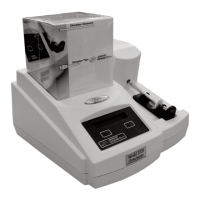Note: Use moderate force to tighten the
solenoid body. DO NOT OVER-
TIGHTEN.
21. Insert the impactor, spring, spring retain-
er, and washer (if present) into the sole-
noid body.
22. Press the impactor against the solenoid
body and, sliding the .160 gauge pin in
and out, check to make sure that it still
has a light, even drag between the inner,
small end of the impactor and the gauge
pin. If the gauge pin is too loose or tight,
shims should be added or subtracted until
the desired light, even drag is felt. It is
recommended that shims be added or sub-
tracted in increments of .001 inches.
23. Position the solenoid wire leads back
down the outside of the solenoid body
and hold in place with the cable tie.
24. Reinstall the solenoid impactor retaining
bracket.
25. Install the sample probe.
26. Add Loctite 222 thread lock (or equiva-
lent) to the two standoffs securing the
sample probe. Install the standoffs (B)
and tighten each using the following
sequence to avoid damaging the sample
probe or cooling well housing:
a. Tighten both standoffs finger-tight.
b. Using a nut driver or wrench, tighten
each standoff 1/2 turn.
c. Tighten each standoff an additional
1/4 turn.
The sample probe should be tight, with a
slight bow.
Note: The spacer and the probe may be
touching each other, or there may be a
small gap between the two parts.
Either condition is acceptable.
However, no gap is allowed between
the standoffs and the probe. The spac-
er may not be present on all instru-
ments. It has been integrated into the
sample well housing.
27. Reassemble the instrument by reversing
steps 1-4.
332P353 Rev2
(3325 Service Manual)
Page 3 of 3

